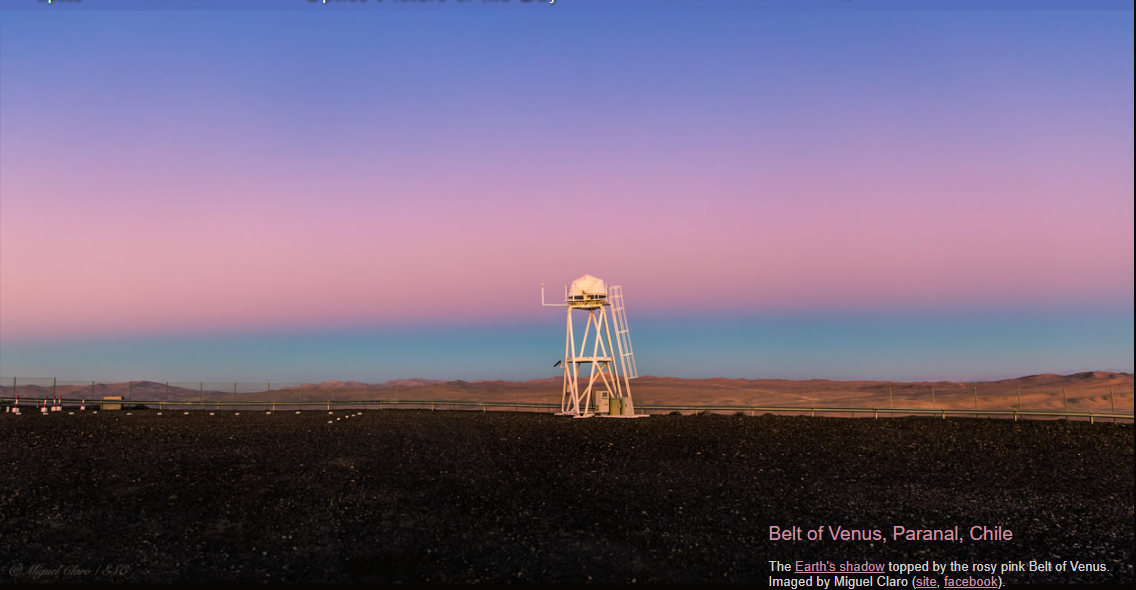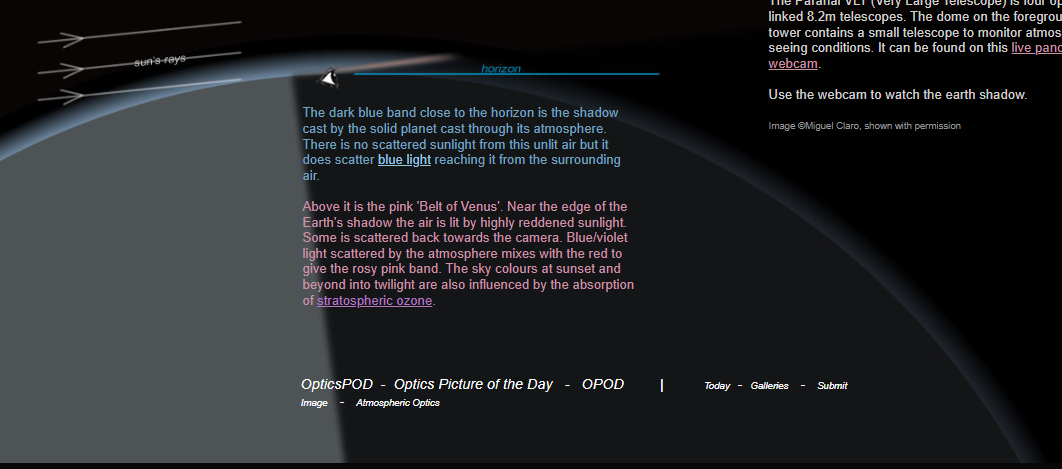Earth's Shadow, ESO Paranal Observatory - OPOD
Earth's Shadow and the Belt of Venus at ESO Paranal Observatory
At the European Southern Observatory's Paranal Observatory, nestled on the picturesque Cerro Paranal mountain in Chile, a captivating atmospheric phenomenon can be witnessed: Earth's shadow topped by the rosy pink Belt of Venus. This mesmerizing sight, captured by astrophotographer Miguel Claro, offers a glimpse into the beauty and complexity of our planet's atmosphere.
The Paranal Observatory is home to the Very Large Telescope (VLT), an impressive array of four optically linked 8.2m telescopes. However, it's not just the VLT that attracts attention. The dome on the foreground tower houses a small telescope specifically designed to monitor atmospheric seeing conditions. This allows scientists and astronomers to assess the quality of the sky and make necessary adjustments for optimal observations.
One way to experience the enchanting Earth's shadow is through the live panoramic webcam located at Paranal Observatory. By using this webcam, viewers can witness the gradual emergence of the shadow as the sun sets and marvel at its evolving hues.
The Earth's shadow appears as a dark blue band close to the horizon. It is cast by the solid planet through its atmosphere, resulting in an absence of scattered sunlight in this unlit air. However, the surrounding air does scatter blue light, which interacts with the red light reaching it from the atmosphere, creating a stunning visual effect.
Just above the Earth's shadow lies the pink band known as the Belt of Venus. This ethereal phenomenon occurs near the edge of the Earth's shadow, where the air is illuminated by highly reddened sunlight. Some of this light scatters back towards the camera, blending with the blue/violet light scattered by the atmosphere. The combination of these colors produces the captivating rosy pink hue that characterizes the Belt of Venus.
It is important to note that the colors of the sky during sunset and twilight are also influenced by the absorption of stratospheric ozone. This atmospheric component further contributes to the dynamic and ever-changing palette of colors observed during these magical moments.
Witnessing Earth's shadow and the Belt of Venus at the ESO Paranal Observatory is a testament to the intricate interplay between light, atmosphere, and celestial bodies. It serves as a reminder of the wonders that unfold in our skies, offering a unique perspective on the beauty and complexity of our planet and its atmosphere.
As technology continues to advance and our understanding of atmospheric optics deepens, we can expect to uncover even more captivating phenomena and gain further insights into the intricacies of our ever-changing sky. The Paranal Observatory, with its state-of-the-art equipment and dedication to scientific exploration, remains at the forefront of these discoveries, providing us with breathtaking images and expanding our knowledge of the world above us.
So next time you find yourself gazing at the sky, take a moment to appreciate the subtle yet profound effects that Earth's shadow and the Belt of Venus have on our visual experience. Their presence reminds us of the interconnectedness of our planet and the boundless wonders that await us in the vast expanse of the universe.

Belt of Venus, Paranal, Chile
The Earth's shadow topped by the rosy pink Belt of Venus. Imaged by Miguel Claro (site, facebook).
The locale is Cerro Paranal, the mountain home of the European Southern Observatory's Paranal Observatory.
The Paranal VLT (Very Large Telescope) is four optically linked 8.2m telescopes. The dome on the foreground tower contains a small telescope to monitor atmospheric seeing conditions. It can be found on this live panoramic webcam.
Use the webcam to watch the earth shadow.
Image ©Miguel Claro, shown with permission

The dark blue band close to the horizon is the shadow cast by the solid planet cast through its atmosphere. There is no scattered sunlight from this unlit air but it does scatter blue light reaching it from the surrounding air.
Above it is the pink 'Belt of Venus'. Near the edge of the Earth's shadow the air is lit by highly reddened sunlight. Some is scattered back towards the camera. Blue/violet light scattered by the atmosphere mixes with the red to give the rosy pink band. The sky colours at sunset and beyond into twilight are also influenced by the absorption of stratospheric ozone.
Note: this article has been automatically converted from the old site and may not appear as intended. You can find the original article here.
Reference Atmospheric Optics
If you use any of the definitions, information, or data presented on Atmospheric Optics, please copy the link or reference below to properly credit us as the reference source. Thank you!
-
<a href="https://atoptics.co.uk/blog/earths-shadow-eso-paranal-observatory-opod/">Earth's Shadow, ESO Paranal Observatory - OPOD</a>
-
"Earth's Shadow, ESO Paranal Observatory - OPOD". Atmospheric Optics. Accessed on November 26, 2024. https://atoptics.co.uk/blog/earths-shadow-eso-paranal-observatory-opod/.
-
"Earth's Shadow, ESO Paranal Observatory - OPOD". Atmospheric Optics, https://atoptics.co.uk/blog/earths-shadow-eso-paranal-observatory-opod/. Accessed 26 November, 2024
-
Earth's Shadow, ESO Paranal Observatory - OPOD. Atmospheric Optics. Retrieved from https://atoptics.co.uk/blog/earths-shadow-eso-paranal-observatory-opod/.